Emission Wavelength Limits of a Continuous-Wave Thulium-Doped Fiber Laser Source Operating at 1.94 µm, 2.09 µm or 2.12 µm
Abstract
:1. Introduction
2. Experimental Setup and Cavity Configurations
3. Results
3.1. Thulium-Doped Fiber Characterization
3.2. Output Power Evolution for Different FBG-Imposed Wavelengths
3.3. Output Spectra in the Three Imposed-Wavelength Configurations
3.4. Shortening of the Thulium-Doped Fiber Length
4. Discussion
5. Conclusions
Author Contributions
Funding
Institutional Review Board Statement
Informed Consent Statement
Data Availability Statement
Conflicts of Interest
References
- Jeong, Y.; Sahu, J.K.; Payne, D.N.; Nilsson, J. Ytterbium-doped large-core fiber laser with 1.36 kW continuous-wave output power. Opt. Express 2004, 12, 6088–6092. [Google Scholar] [CrossRef]
- Zellmer, H.; Willamowski, U.; Tünnermann, A.; Welling, H.; Unger, S.; Reichel, V.; Müller, H.-R.; Kirchhof, J.; Albers, P. High-power cw neodymium-doped fiber laser operating at 9.2 W with high beam quality. Opt. Lett. 1995, 20, 578–580. [Google Scholar] [CrossRef] [PubMed]
- Paschotta, R.; Nilsson, J.; Tropper, A.C.; Hanna, D.C. Ytterbium-doped fiber amplifiers. IEEE J. Quantum Electron. 1997, 33, 1049–1056. [Google Scholar] [CrossRef]
- Bellemare, A. Continuous-wave silica-based erbium-doped fibre lasers. Prog. Quantum Electron. 2003, 27, 211–266. [Google Scholar] [CrossRef]
- Yamashita, T.; Qin, G.; Suzuki, T.; Ohishi, Y. A New Green Fiber Laser using Terbium-doped Fluoride fiber. In Proceedings of the OFC/NFOEC 2008—2008 Conference on Optical Fiber Communication/National Fiber Optic Engineers Conference, San Diego, CA, USA, 24–28 February 2008. [Google Scholar] [CrossRef]
- Peterka, P.; Kasik, I.; Dhar, A.; Dussardier, B.; Blanc, W. Theoretical modeling of fiber laser at 810 nm based on thulium-doped silica fibers with enhanced 3H4 level lifetime. Opt. Express 2011, 19, 2773–2781. [Google Scholar] [CrossRef] [PubMed]
- Hemming, A.; Simakov, N.; Haub, J.; Carter, A. A review of recent progress in holmium-doped silica fibre sources. Opt. Fiber Technol. 2014, 20, 621–630. [Google Scholar] [CrossRef]
- Meleshkevich, M.; Platonov, N.; Gapontsev, D.; Drozhzhin, A.; Sergeev, V.; Gapontsev, V. 415 W Single-Mode CW Thulium Fiber Laser in all-fiber format. In Proceedings of the CLEO/Europe and IQEC 2007 Conference Digest, Munich, Germany, 17–22 June 2007. [Google Scholar] [CrossRef]
- Hemming, A.; Bennetts, S.; Davidson, A.; Carmody, N.; Lancaster, D.G. A 226W high power Tm fibre laser. In Proceedings of the OECC/ACOFT 2008—2008 Joint Conference of the Opto-Electronics and Communications Conference and the Australian Conference on Optical Fibre Technology, Sydney, NSW, Australia, 7–10 July 2008. [Google Scholar] [CrossRef]
- Moulton, P.F.; Rines, G.A.; Slobodtchikov, E.V.; Wall, K.F.; Frith, G.; Samson, B.; Carter, A.L.G. Tm-Doped Fiber Lasers: Fundamentals and Power Scaling. IEEE J. Sel. Top. Quantum Electron. 2009, 15, 85–92. [Google Scholar] [CrossRef]
- Tang, Y.; Huang, C.; Wang, S.; Li, H.; Xu, J. High-power narrow-bandwidth thulium fiber laser with an all-fiber cavity. Opt. Express 2012, 20, 17539–17544. [Google Scholar] [CrossRef]
- Simakov, N.; Hemming, A.V.; Carter, A.; Farley, K.; Davidson, A.; Carmody, N.; Hughes, M.; Daniel, J.M.O.; Corena, L.; Stepanov, D.; et al. Design and experimental demonstration of a large pedestal thulium-doped fibre. Opt. Express 2015, 23, 3126–3133. [Google Scholar] [CrossRef]
- Walbaum, T.; Heinzig, M.; Schreiber, T.; Eberhardt, R.; Tünnermann, A. Monolithic thulium fiber laser with 567 W output power at 1970 nm. Opt. Lett. 2016, 41, 2632–2635. [Google Scholar] [CrossRef]
- Ramírez-Martínez, N.J.; Núñez-Velázquez, M.; Umnikov, A.A.; Sahu, J.K. Highly efficient thulium-doped high-power laser fibers fabricated by MCVD. Opt. Express 2019, 27, 196–201. [Google Scholar] [CrossRef]
- Ehrenreich, T.; Leveille, R.; Majid, I.; Tankala, K. 1-kW, All-Glass Tm fiber Laser. In Proceedings of the SPIE Photonics West 2010: LASE, San Francisco, CA, USA, 23–28 January 2010. Conference 7580.
- Wang, X.; Zhou, P.; Wang, X.; Xiao, H.; Si, L. 102 W monolithic single frequency Tm-doped fiber MOPA. Opt. Express 2013, 21, 32386–32392. [Google Scholar] [CrossRef]
- Liu, J.; Shi, H.; Liu, K.; Hou, Y.; Wang, P. 210 W single-frequency, single-polarization, thulium-doped all-fiber MOPA. Opt. Express 2014, 22, 13572–13578. [Google Scholar] [CrossRef]
- Wang, X.; Jin, X.; Zhou, P.; Wang, X.; Xiao, H.; Liu, Z. High power, widely tunable, narrowband superfluorescent source at 2 µm based on a monolithic Tm-doped fiber amplifier. Opt. Express 2015, 23, 3382–3389. [Google Scholar] [CrossRef] [PubMed]
- Shah, L.; Sims, R.A.; Kadwani, P.; Willis, C.C.; Bradford, J.B.; Sincore, A.; Richardson, M. High-power spectral beam combining of linearly polarized Tm:fiber lasers. Appl. Opt. 2015, 54, 757–762. [Google Scholar] [CrossRef] [PubMed]
- Yin, K.; Zhu, R.; Zhang, B.; Liu, G.; Zhou, P.; Hou, J. 300 W-level, wavelength-widely-tunable, all-fiber integrated thulium-doped fiber laser. Opt. Express 2016, 24, 11085–11090. [Google Scholar] [CrossRef] [PubMed]
- Goodno, G.D.; Book, L.D.; Rothenberg, J.E. Low-phase-noise, single-frequency, single-mode 608 W thulium fiber amplifier. Opt. Lett. 2009, 34, 1204–1206. [Google Scholar] [CrossRef]
- Yao, W.; Shen, C.; Shao, Z.; Wang, J.; Wang, F.; Zhao, Y.; Shen, D. 790 W incoherent beam combination of a Tm-doped fiber laser at 1941 nm using a 3 × 1 signal combiner. Syst. Control Lett. 2018, 57, 5574–5577. [Google Scholar] [CrossRef] [PubMed]
- Liu, Y.; Li, H.; Yang, L.; Dai, N.; Li, J.; Cao, C.; Xing, Y.; Liao, L.; Cao, R.; Zhang, F.; et al. 406 W Narrow-Linewidth All-Fiber Amplifier With Tm-Doped Fiber Fabricated by MCVD. IEEE Photon. Technol. Lett. 2019, 31, 1779–1782. [Google Scholar] [CrossRef]
- Liu, Y.Z.; Xing, Y.B.; Liao, L.; Wang, Y.B.; Peng, J.G.; Li, H.Q.; Dai, N.L.; Li, J.Y. 530 W all-fiber continuous-wave Tm-doped fiber laser. Acta Phys. Sin. 2019, 69, 184209. [Google Scholar] [CrossRef]
- Shin, J.S.; Cha, Y.H.; Chun, B.J.; Jeong, D.Y.; Park, H. 200-W Continuous-wave Thulium-doped All-fiber Laser at 2050 nm. Curr. Opt. Photonics 2021, 4, 306–310. [Google Scholar] [CrossRef]
- Anderson, B.M.; Soloman, J.; Flores, A. 1.1 kW, beam-combinable thulium doped all-fiber amplifier. In Proceedings of the SPIE Photonics West 2021: LASE, San Francisco, CA, USA, 6–11 March 2021. Proceedings SPIE 11665. [Google Scholar] [CrossRef]
- Romano, C.; Panitzek, D.; Lorenz, D.; Forster, P.; Eichhorn, M.; Kieleck, C. High-Power Thulium-Doped Fiber MOPA Emitting at 2036 nm. J. Light. Technol. 2024, 42, 394–398. [Google Scholar] [CrossRef]
- Michalska, M.; Honzatko, P.; Grzes, P.; Kamradek, M.; Podrazky, O.; Kasik, I.; Swiderski, J. Thulium-Doped 1940- and 2034-nm Fiber Amplifiers: Towards Highly Efficient, High-Power All-Fiber Laser Systems. J. Light. Technol. 2024, 42, 339–346. [Google Scholar] [CrossRef]
- Ren, C.; Shen, Y.; Zheng, Y.; Mao, Y.; Wang, F.; Shen, D.; Zhu, H. Widely-tunable all-fiber Tm doped MOPA with >1 kW of output power. Opt. Express 2023, 31, 22733–22739. [Google Scholar] [CrossRef] [PubMed]
- Hemming, A.; Simakov, N.; Davidson, A.; Oermann, M.; Corena, L.; Stepanov, D.; Carmody, N.; Haub, J.; Swain, R.; Carter, A. Development of high-power holmium-doped fibre amplifiers. In Proceedings of the SPIE Photonics West 2014: LASE, San Francisco, CA, USA, 1–6 February 2014. Proceedings SPIE 8961. [Google Scholar] [CrossRef]
- Hemming, A.; Simakov, N.; Davidson, A.; Bennetts, S.; Hughes, M.; Carmody, N.; Davies, P.; Corena, L.; Stepanov, D.; Haub, J.; et al. A monolithic cladding pumped holmium-doped fibre laser. In Proceedings of the 2013 Conference on Lasers and Electro-Opics, San Jose, CA, USA, 9–14 June 2013. [Google Scholar] [CrossRef]
- Hemming, A.; Bennetts, S.; Simakov, N.; Davidson, A.; Haub, J.; Carter, A. High power operation of cladding pumped holmium-doped silica fibre lasers. Opt. Express 2013, 21, 4560–4566. [Google Scholar] [CrossRef]
- Le Gouët, J.; Gustave, F.; Bourdon, P.; Robin, T.; Laurent, A.; Cadier, B. Realization and simulation of high-power holmium doped fiber lasers for long-range transmission. Opt. Express 2020, 28, 22307–22320. [Google Scholar] [CrossRef]
- Beaumont, B.; Bourdon, P.; Barnini, A.; Kervella, L.; Robin, T.; Le Gouët, J. High efficiency holmium-doped triple-clad fiber laser at 2120 nm. J. Light. Tehchnol. 2022, 40, 6480–6485. [Google Scholar] [CrossRef]
- Ramírez-Martínez, N.J.; Núñez-Velázquez, M.; Sahu, J.K. Study on the dopant concentration ratio in thulium-holmium doped silica fibers for lasing at 2.1 µm. Opt. Express 2020, 28, 24961–24967. [Google Scholar] [CrossRef]
- Jackson, S.; Sabella, A.; Hemming, A.; Bennetts, S.; Lancaster, D. High-Power 83 W Holmium-Doped Silica Fiber Laser Operating with High Beam Quality. Opt. Lett. 2007, 32, 241–243. [Google Scholar] [CrossRef] [PubMed]
- Dalloz, N.; Robin, T.; Cadier, B.; Kieleck, C.; Eichhorn, M.; Hildenbrand-Dhollande, A. 55 W actively Q-switched single oscillator Tm3+, Ho3+-codoped silica polarization maintaining 2.09 µm fiber laser. Opt. Express 2019, 27, 8387–8394. [Google Scholar] [CrossRef]
- Forster, P.; Romano, C.; Kieleck, C.; Eichhorn, M. Advances in two-micron lasers for nonlinear conversion into the mid-IR. In Proceedings of the SPIE Photonics Europe, Online, 6–10 April 2020. Proceedings SPIE 11355. [Google Scholar] [CrossRef]
- Motard, A.; Louot, C.; Robin, T.; Cadier, B.; Manek-Hönninger, I.; Dalloz, N.; Hildenbrand-Dhollande, A. Diffraction limited 195-W continuous wave laser emission at 2.09 µm from a Tm3+, Ho3+-codoped single-oscillator monolithic fiber laser. Opt. Express 2021, 29, 6599–6607. [Google Scholar] [CrossRef] [PubMed]
- Forster, P.; Romano, C.; Schneider, J.; Eichhorn, M.; Kieleck, C. High-power continuous-wave Tm3+:Ho3+-codoped fiber laser operation from 2.1 µm to 2.2 µm. Opt. Lett. 2022, 47, 2542–2545. [Google Scholar] [CrossRef] [PubMed]
- Motard, A.; Louot, C.; Manek-Hönninger, I.; Dalloz, N.; Hildenbrand-Dhollande, A. Optimizing the Performance of a Monolithic Tm3+, Ho3+-Codoped Fiber Laser by FBG reflected wavelength and Fiber Gain Matching. Opt. Express 2023, 31, 18939–18948. [Google Scholar] [CrossRef] [PubMed]
- Zervas, M.N.; Codemard, C.A. High Power Fiber Lasers: A Review. IEEE J. Sel. Top. Quantum Electron. 2014, 20, 0904123. [Google Scholar] [CrossRef]
- Wang, Z.; Zhang, B.; Liu, J.; Song, Y.; Zhang, H. Recent developments in mid-infrared fiber lasers: Status and challenges. Opt. Laser Technol. 2020, 132, 106497. [Google Scholar] [CrossRef]
- Mawst, L.J.; Botez, D. High-Power Mid-Infrared (λ∼3–6 µm) Quantum Cascade Lasers. IEEE Photonics J. 2022, 14, 1–25. [Google Scholar] [CrossRef]
- Medina, M.A.; Piotrowski, M.; Schellhorn, M.; Wagner, F.R.; Berrou, A.; Hildenbrand-Dhollande, A. Beam quality and efficiency of ns-pulsed high-power mid-IR ZGP OPOs compared in linear and non-planar ring resonators. Opt. Express 2021, 29, 21727–21737. [Google Scholar] [CrossRef]
- Gladyshev, A.V.; Kosolapov, A.F.; Khudyakov, M.M.; Yatsenko, Y.P.; Kolyadin, A.N.; Krylov, A.A.; Pryamikov, A.D.; Biriukov, A.S.; Likhachev, M.E.; Bufetov, I.A. 4.4-µm Raman laser based on hollow-core silica fibre. Quantum Electron. 2017, 47, 491. [Google Scholar] [CrossRef]
- Scurria, G.; Manek-Hönninger, I.; Carré, J.Y.; Hildenbrand-Dhollande, A.; Bigotta, S. 7 W mid-infrared supercontinuum generation up to 4.7 µm in an indium-fluoride optical fiber pumped by a high-peak power thulium-doped fiber single-oscillator. Opt. Express 2020, 28, 7672–7677. [Google Scholar] [CrossRef]
- Piotrowski, M.; Medina, M.A.; Schellhorn, M.; Spindler, G.; Hildenbrand-Dhollande, A. Effects of pump pulse energy and repetition rate on beam quality in a high-power mid-infrared ZnGeP2 OPO. Opt. Express 2021, 29, 2577–2586. [Google Scholar] [CrossRef] [PubMed]
- Fried, N.M.; Murray, K.E. High-power thulium fiber laser ablation of urinary tissues at 1.94 µm. J. Endourol. 2005, 19, 25–31. [Google Scholar] [CrossRef]
- Fried, N.M. High-power laser vaporization of the cani-neprostate using a 110W Thulium fiber laser at 1.91 µm. Lasers Surg. Med. 2005, 36, 52–56. [Google Scholar] [CrossRef]
- Warnaby, C.E.; Coleman, D.J.; King, T.A. Photothermal modelling of thulium fibre laser-tissue interactions. In Proceedings of the European Conference on Biomedical Optics 2003: Therapeutic Laser Applications and Laser-Tissue Interactions 2003, Munich, Germany, 24–25 June 2003. Proceedings SPIE 5142-68. [Google Scholar] [CrossRef]
- Zhu, X.; Jiang, S. 2 µm Fiber Laser Enable Versatile Processing of Plastics. Ind. Laser Solut. Manuf. 2016, 31, 18–23. [Google Scholar]
- Mingareev, I.; Weirauch, F.; Olowinsky, A.; Shah, L.; Kadwani, P.; Richardson, M. Welding of polymers using a 2 µm thulium fiber laser. Opt. Laser Technol. 2012, 44, 2095–2099. [Google Scholar] [CrossRef]
- Barrientos Barria, J.; Mammez, D.; Cadiou, E.; Dherbecourt, J.B.; Raybaut, M.; Schmid, T.; Bresson, A.; Melkonian, J.M.; Godard, A.; Pelon, J.; et al. Multispecies high-energy emitter for CO2, CH4, and H2O monitoring in the 2 µm range. Opt. Lett. 2014, 39, 6719–6722. [Google Scholar] [CrossRef] [PubMed]
- Koch, G.J.; Beyon, J.Y.; Petzar, P.E.; Petros, M.; Yu, J.; Trieu, B.C.; Kavaya, M.J.; Singh, U.N.; Modlin, E.A.; Barnes, B.W.; et al. Field testing of a high-energy 2 µm Doppler LIDAR. J. Appl. Remote Sens. 2010, 4, 043512. [Google Scholar] [CrossRef]
- Koch, G.J.; Beyon, J.Y.; Barnes, B.W.; Petros, M.; Yu, J.; Amzajerdian, F.; Kavaya, M.J.; Singh, U.N. High-energy 2 µm doppler lidar for wind measurements. Opt. Eng. 2007, 46, 116201. [Google Scholar] [CrossRef]
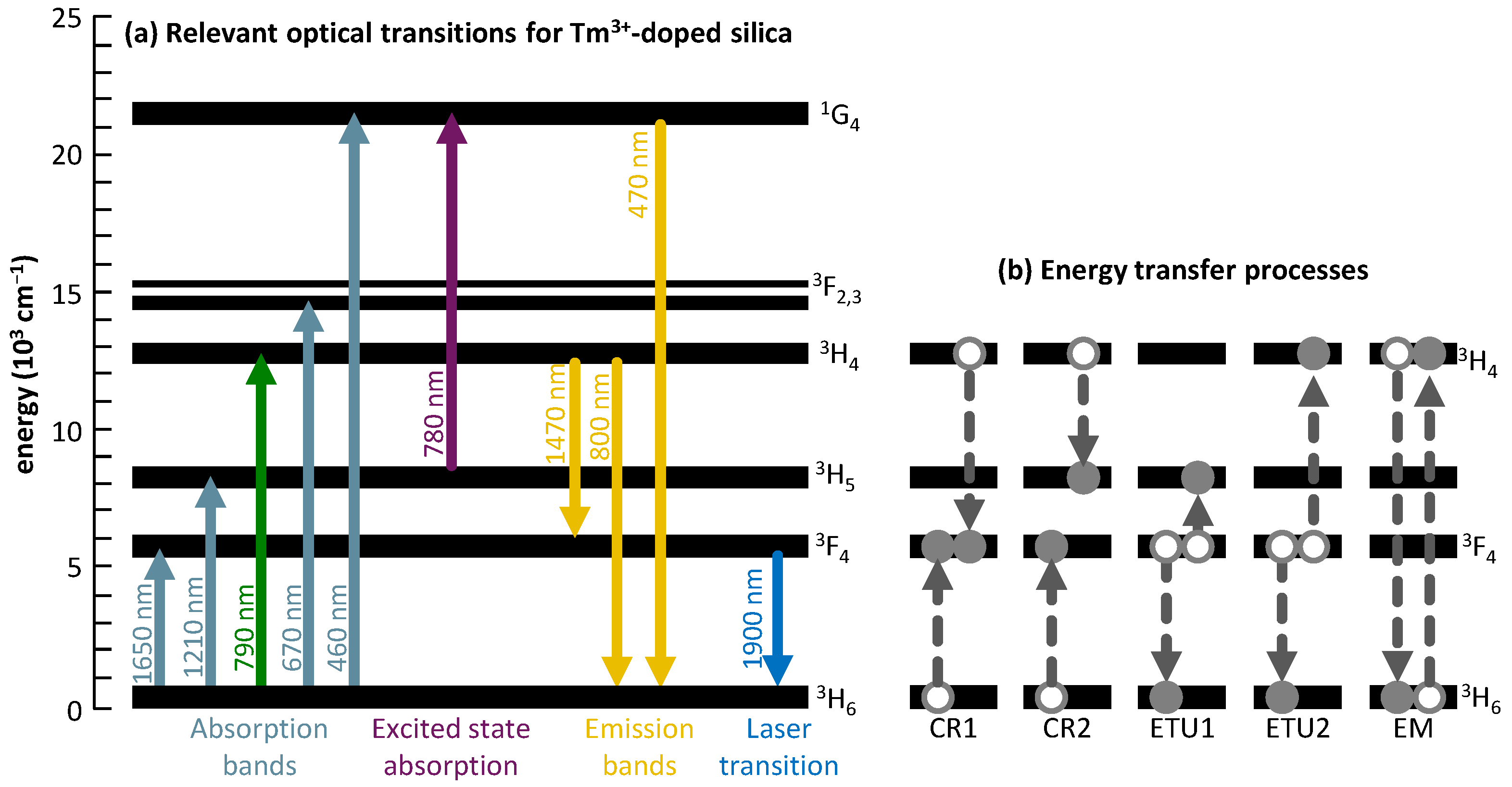
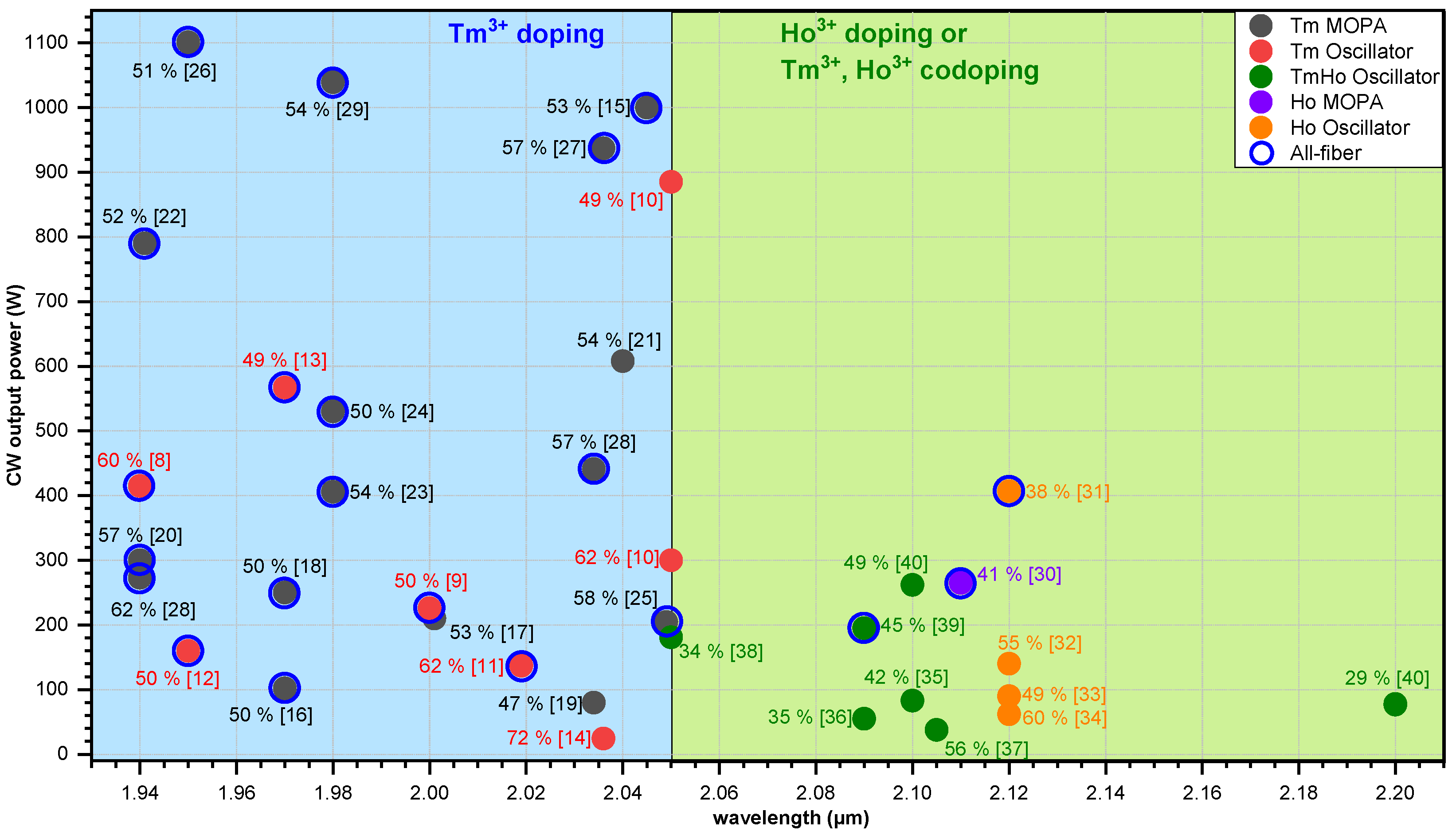
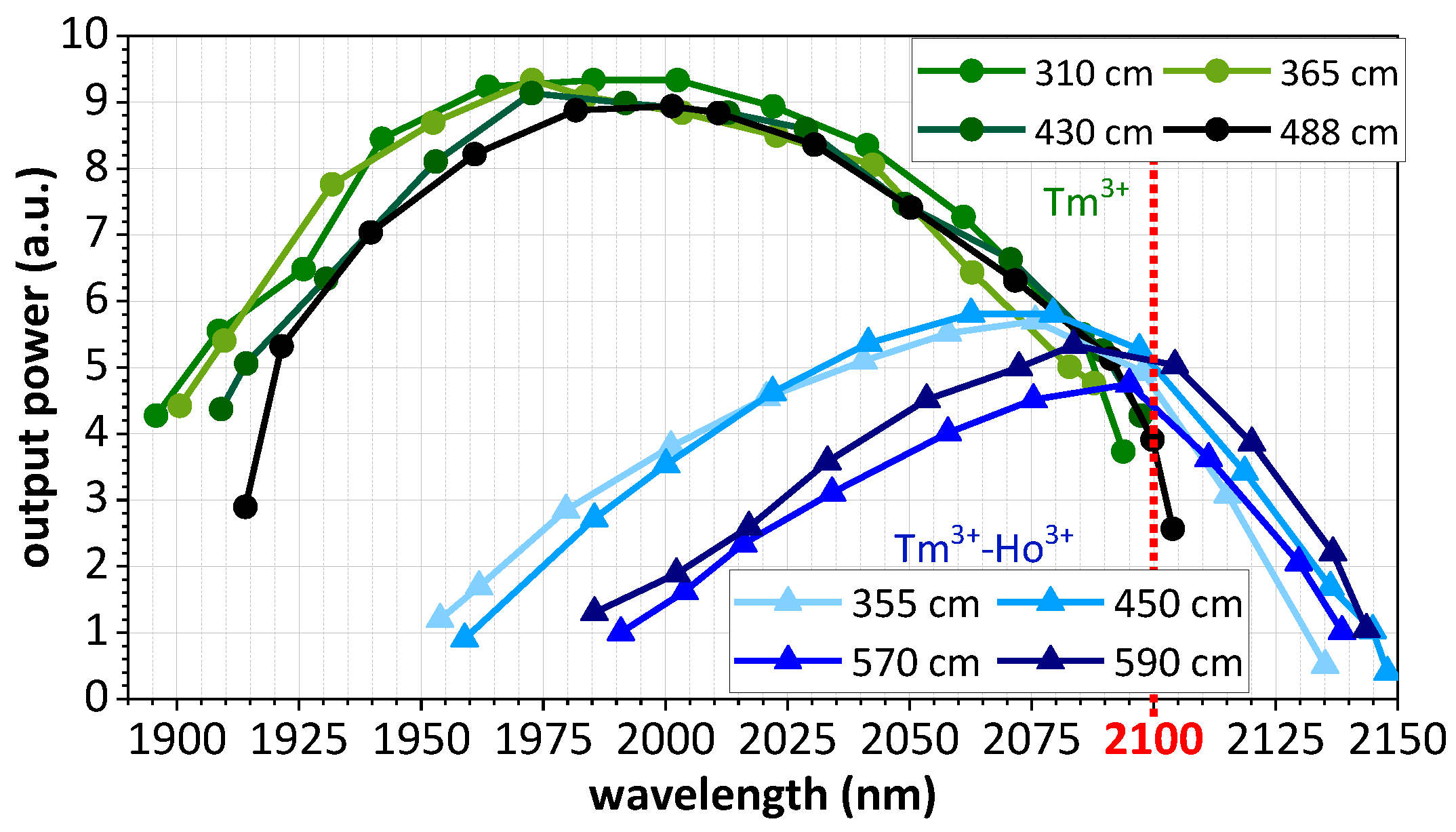

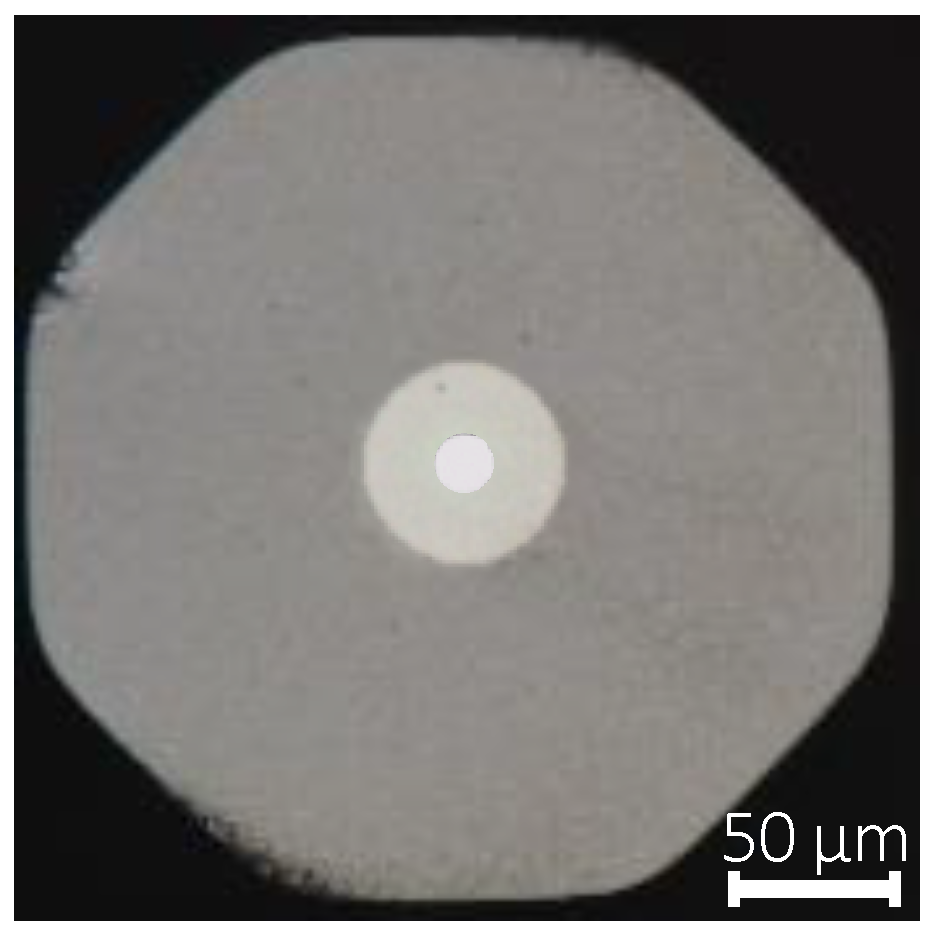
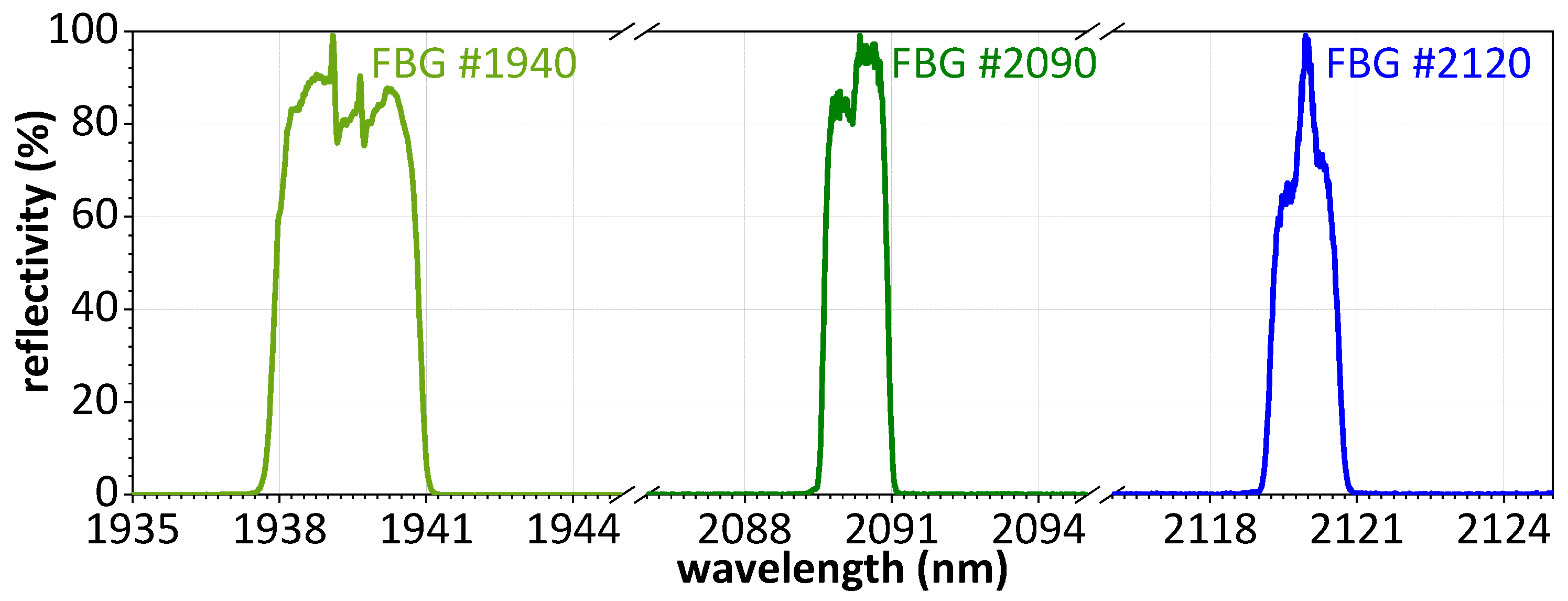



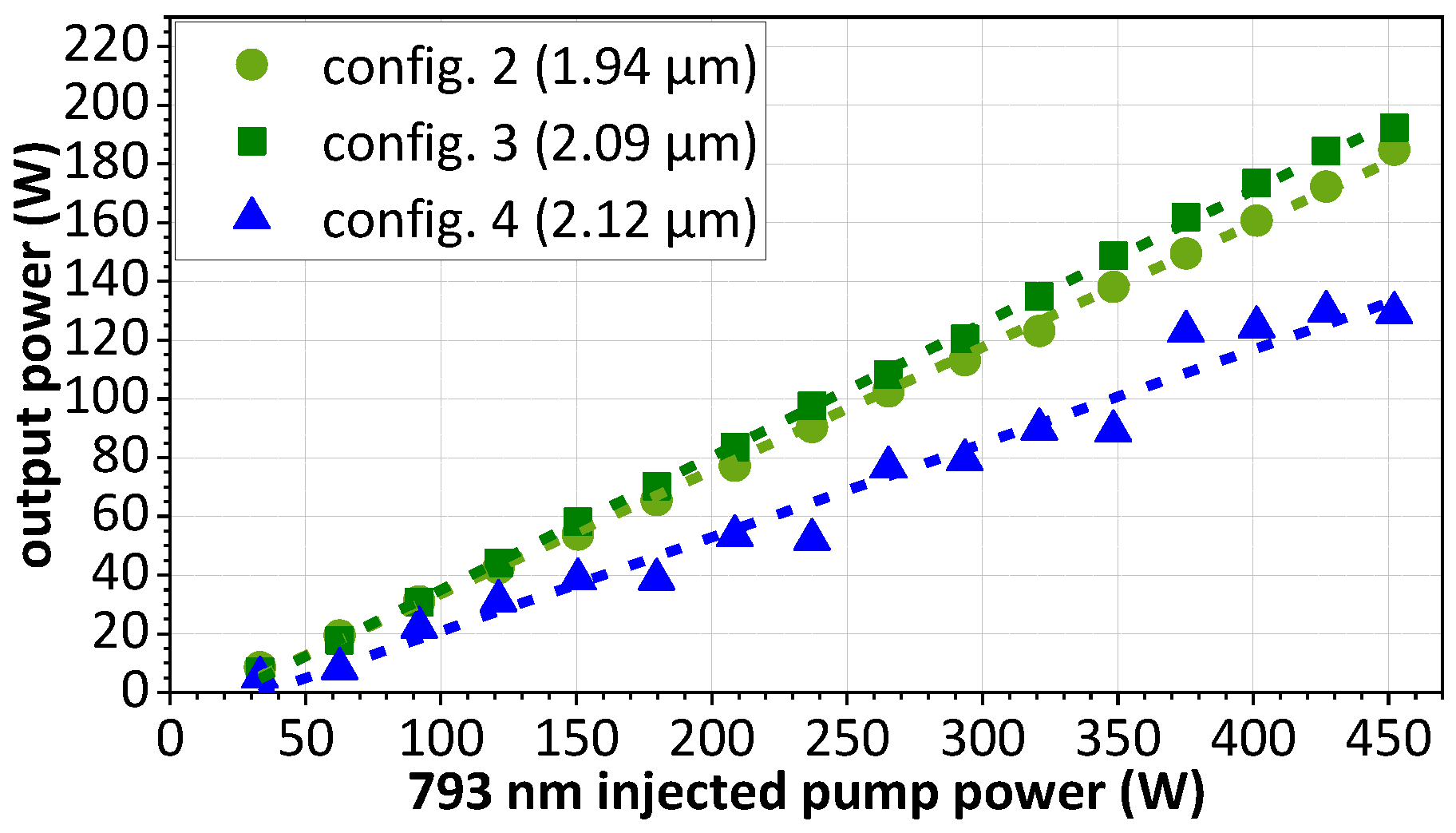
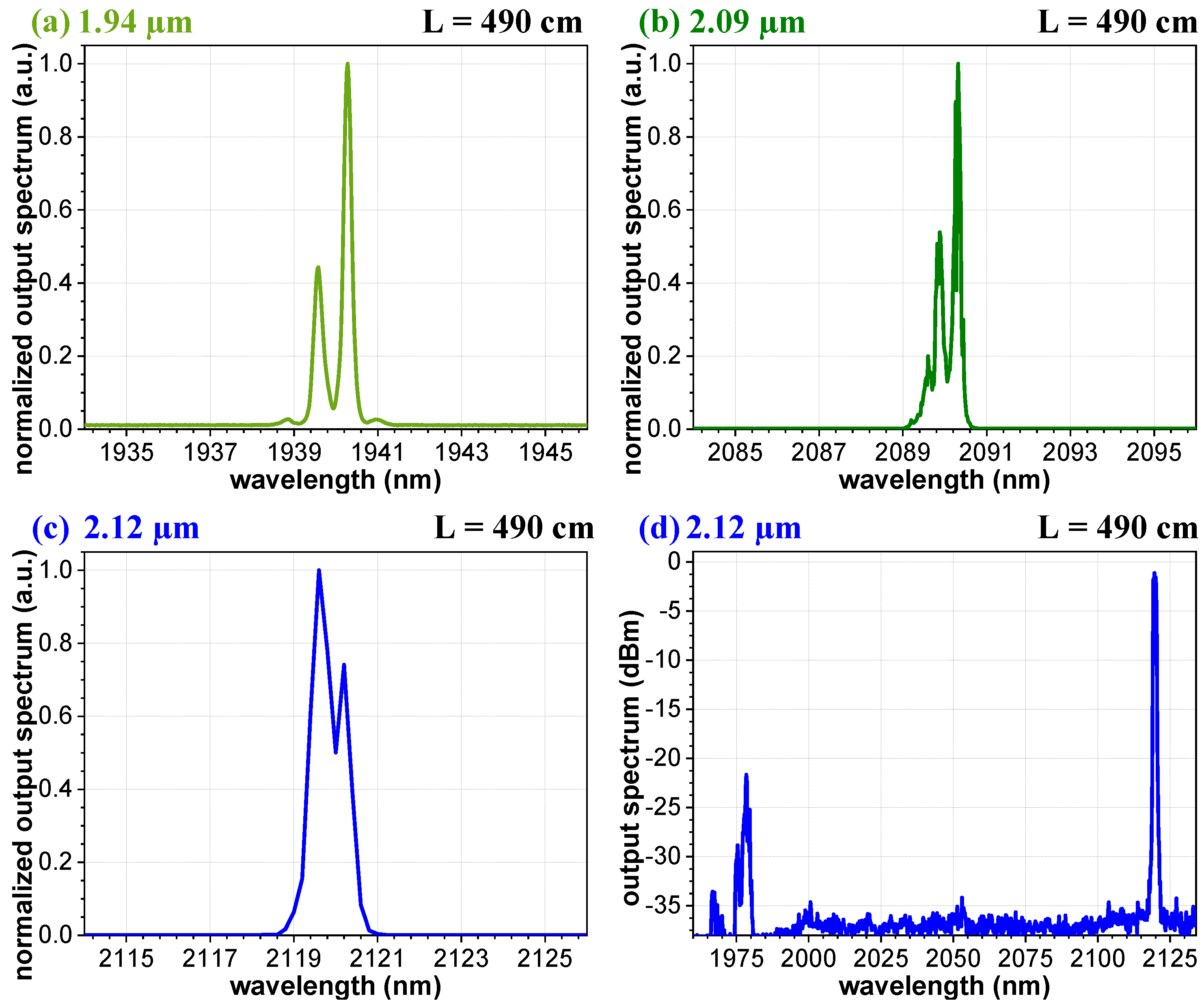


| Config. | 1 | 2 | 3 | 4 |
|---|---|---|---|---|
| FBG | None | #1940 | #2090 | #2120 |
| Reflectivity (%) | 4 | 99 | 99 | 99 |
| Central wavelength (nm) | - | 1939.38 | 2090.60 | 2120.0 |
| FWHM bandwidth (nm) | - | 2.92 | 1.26 | 1.27 |
| Fiber type | PAS 20/250 | PAS 20/250 | PAS PM 20/300 | PAS PM 20/300 |
| Fiber NA | 0.11 | 0.11 | 0.08 | 0.08 |
| End cleave | 0° | 8° | 8° | 8° |
| Config. | 2 | 3 | 4 |
|---|---|---|---|
| FBG | #1940 | #2090 | #2120 |
| Maximum output power (W) | 185 | 193 | 132 |
| Slope efficiency (%) | 42.0 | 45.6 | 22.8 |
| Power threshold (W) | 19.9 | 22.8 | 34.6 |
| Config. | 2’ | 3’ |
|---|---|---|
| FBG | #1940 | #2090 |
| Maximum output power (W) | 191 | 131 |
| Slope efficiency (%) | 43.2 | 29.6 |
| Power threshold (W) | 19.7 | 12.8 |
Disclaimer/Publisher’s Note: The statements, opinions and data contained in all publications are solely those of the individual author(s) and contributor(s) and not of MDPI and/or the editor(s). MDPI and/or the editor(s) disclaim responsibility for any injury to people or property resulting from any ideas, methods, instructions or products referred to in the content. |
© 2024 by the authors. Licensee MDPI, Basel, Switzerland. This article is an open access article distributed under the terms and conditions of the Creative Commons Attribution (CC BY) license (https://creativecommons.org/licenses/by/4.0/).
Share and Cite
Louot, C.; Sanson, F.; Motard, A.; Ibach, T.; Manek-Hönninger, I.; Berrou, A.; Dalloz, N.; Robin, T.; Cadier, B.; Hildenbrand-Dhollande, A. Emission Wavelength Limits of a Continuous-Wave Thulium-Doped Fiber Laser Source Operating at 1.94 µm, 2.09 µm or 2.12 µm. Photonics 2024, 11, 246. https://doi.org/10.3390/photonics11030246
Louot C, Sanson F, Motard A, Ibach T, Manek-Hönninger I, Berrou A, Dalloz N, Robin T, Cadier B, Hildenbrand-Dhollande A. Emission Wavelength Limits of a Continuous-Wave Thulium-Doped Fiber Laser Source Operating at 1.94 µm, 2.09 µm or 2.12 µm. Photonics. 2024; 11(3):246. https://doi.org/10.3390/photonics11030246
Chicago/Turabian StyleLouot, Christophe, Félix Sanson, Arnaud Motard, Thierry Ibach, Inka Manek-Hönninger, Antoine Berrou, Nicolas Dalloz, Thierry Robin, Benoit Cadier, and Anne Hildenbrand-Dhollande. 2024. "Emission Wavelength Limits of a Continuous-Wave Thulium-Doped Fiber Laser Source Operating at 1.94 µm, 2.09 µm or 2.12 µm" Photonics 11, no. 3: 246. https://doi.org/10.3390/photonics11030246
APA StyleLouot, C., Sanson, F., Motard, A., Ibach, T., Manek-Hönninger, I., Berrou, A., Dalloz, N., Robin, T., Cadier, B., & Hildenbrand-Dhollande, A. (2024). Emission Wavelength Limits of a Continuous-Wave Thulium-Doped Fiber Laser Source Operating at 1.94 µm, 2.09 µm or 2.12 µm. Photonics, 11(3), 246. https://doi.org/10.3390/photonics11030246





